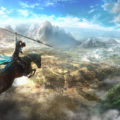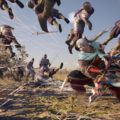Cognition Dissemination: The Flailing Dynasty Warriors

Luck hasn’t been on Koei Tecmo’s side in a little more than the last year. Between two of the developers they own, Omega Force and Gust, none of their titles have sold well in their home country of Japan. Their sequels have sold below preceding installments.
This trend has been mostly noticeable through sales of their Warriors games. It’s tough to remember the time when these titles were platinum sellers in Japan during the PS2 days, when they sold nearly half a million at least out of the gate. But the Dynasty Warriors and Samurai Warriors franchises, along with several spinoffs and adaptations, have fallen off in terms of sales lately — and in terms of quality for some.
The only notable exception for their overall software here was Nioh, one of Koei Tecmo’s most successful games worldwide. Dead or Alive 5’s copious amount of DLC might have done well, too, though numbers were never released to show this. They’re probably thankful they own Team Ninja.
While Dynasty Warriors 8 and Samurai Warriors 4 did well, the same couldn’t be said for most subsequent titles. Dynasty Warriors 8: Empires, for instance, opened at around 50,000 between the PS4 and PS3 versions, well below even other Empires iterations. The same could be said of Samurai Warriors 4-II, which sold a little over 90,000 after launching on all three Sony platforms. The trend was also noticeable with licensed spinoffs like Arslan: The Warriors of Legend and Berserk and the Band of the Hawk, which were barely acknowledged in Japan. The only titles that were exempt from this were the Dragon Quest Heroes games, though those were published by Square Enix, while Hyrule Warriors did well worldwide.

Fortunately, Koei Tecmo realized this, and made serious changes with Dynasty Warriors 9. The franchise went open world for the first time, and with that came new features like the existence of combat scenarios occurring simultaneously around its world of ancient China, and smaller activities like hunting for resources, visiting and staying in towns, and embarking on quests for NPCs. The combat was also revamped so it could take advantage of the larger open spaces. It sounded like they were on the right track, despite early video previews showing how the performance struggled at times.
Unfortunately, the experiment didn’t go well, according to critics and the general gaming audience. Nearly every element that longtime fans feared could go wrong went wrong.
The open world is reportedly barren, with miles upon miles of space that seemingly exists just for the sake of having a large open world, and it takes far too long to travel from one destination to the next. Some combat changes aren’t to everyone’s liking, as instead of having several large skirmishes taking place within close distances like in previous games, they’re all spread out and take time to travel to. Specific characters also lost their unique weapons, and are using those from other characters now, though they notably have different techniques with those weapons. The original weapons for some of those characters are paid-DLC, which is rather scummy. Lastly, the game has some performance issues on every platform, but even on PlayStation 4 Pro and Xbox One X.
The game is being compared to Dynasty Warriors 6, where Koei Tecmo also tried some experimentation that didn’t turn out well. Also, like DW9, 6 was the first DW game made for then-current-generation consoles on PS3 and 360, so perhaps it was destined to share its fate.

The game sold 117,495 in its first week on sale in Japan, noticeably low for the franchise. As the Gematsu article states for comparison’s sake, Dynasty Warriors 7 sold 253,090 copies in its first week while DW8 did 203,224, both of which released on PS3. This shows how the series was on a downward trend sales-wise, though this might be a steeper drop than expected. The game has sold nearly 18,000 copies on Steam worldwide thus far, which isn’t help by how the PC version is noticeably worse than the console versions.
It’s tough to judge its sales at the moment because this is the first installment where Koei Tecmo heavily advertised the title to the Asian market, where games are rising in popularity — particularly in China. These markets have no official sales trackers, so it will be difficult to determine whether it’s a success there unless Koei Tecmo says so themselves. If it’s overwhelmingly successful there, they’ll confirm that through a press release or in a financial briefing. But that’s not a guarantee.
Given the lack of success they’ve had with their games, Koei Tecmo will need to get out of their comfort zone and experiment with many of their existing franchises, and create new properties. They’ve shown little signs that they’re gutsy enough to do this, but they’ll have to try something that will reattract older fans and lure some new ones in. If they maintain these current trends, they’ll be a licensing studio soon enough.






When your games are in the shitter, DLC should never have even come up during the game’s development, everything that made the franchise great in the first place should have been included, and somebody should have played the fucking thing before releasing that mess to the rest of the world. The decisions behind DW9 make no sense. Anyone in charge of that game could have gone on any major social network and asked for thoughts on how to make this successful, and I guarantee you those ideas would have been far better than what was done with this. It’s baffling.
Yeah, someone should have told them that all games don’t need to be open world, even though it’s a fashionable thing. And saving some weapons as DLC is… yikes. How did they think that would go? Koei Tecmo’s developers really need to carefully consider their plans for the future, or they’ll have to enjoy making games for other studios.